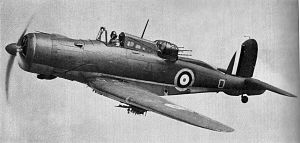Blackburn Roc
| B-25 Roc | |
|---|---|
 |
|
| Role | Carrier-based fighter |
| Manufacturer |
Blackburn Aircraft Boulton Paul |
| Designer | George Edward Petty |
| First flight | 23 December 1938 |
| Introduction | April 1939 |
| Retired | 1943 |
| Primary user | Fleet Air Arm |
| Number built | 136 |
| Variants | Blackburn Skua |
The Blackburn B-25 Roc was a British Second World War-era Fleet Air Arm fighter aircraft designed by Blackburn Aircraft Ltd. It took its name from the mythical bird of the tales of the Arabian Nights, the Roc. Derived from the Blackburn Skua and developed in parallel, the Roc differed in its adoption of a turret for its armament. Operationally, the Roc came to be viewed as inferior to existing aircraft such as the Skua, and the type had only brief front line service.
On 31 December 1935, the British Air Ministry issued specification O.30/35 for a carrier-based turret-armed fighter.Blackburn proposed a derivative of the Blackburn Skua dive bomber, of which two prototypes had been ordered for the Fleet Air Arm earlier that year, while Boulton Paul proposed the P.85, a redesigned version of its land-based Defiant P.82 turret fighter, with either a Hercules radial or Merlin inline engine. Although the "Sea Defiant" was expected to be 85 mph (137 km/h) faster, the Roc was chosen.
Like the Skua, the B-25 Roc was a two-seat low-wing cantilever monoplane of all-metal construction, fitted with a retractable tailwheel undercarriage, while its wings folded for storage aboard aircraft carriers. It was powered by a Bristol Perseus radial engine driving a three-bladed propeller, and used the same Boulton Paul power operated gun turret as the Defiant, with four .303 in (7.7 mm) Browning machine guns. It retained the wing-mounted dive brakes of the Skua, with bomb racks under each wing for two 250 lb (110 kg) bombs and eight practice bombs to be carried.
...
Wikipedia
